My visit to Handa with Scottish Wildlife Trust
I had looked across to Handa island from the mainland a number of times and promised myself that one day I would visit the island as I heard it was a wildlife reserve and a great place to visit, however with work commitments time passed and I never managed to visit.
Once I retired from work I became a volunteer with Scottish Wildlife Trust (SWT) at Montrose Basin and I discovered that Handa Island (one of 120 SWT reserves) is one of the largest seabird colonies in north west Europe.
A year later I was helping refurbish the dipping pond at Montrose Basin with Anna, the reserve ranger who asked me if I would be interested in volunteering for a week on Handa and if so I should go and see Emma, which I did immediately and she soon had me fixed up for a week’s volunteering on Handa Island along with Chris a European Volunteer (EVS) from Malta who is volunteering for one year at Loch of the Lowes.
On the Saturday, the day for the trip, we travelled to Tarbet in the far north west of Scotland. On arrival, we introduced ourselves to Rodger the ferry master who operates the ferry which takes all volunteers and visitors to the Island.
With Rodgers help we loaded our bags and our food for a week’s stay on Handa on to the ferry and we set off up Handa sound heading for the island, on the way we saw a few Red-throated Divers and Shags in the water and a White-tailed Eagle above us.
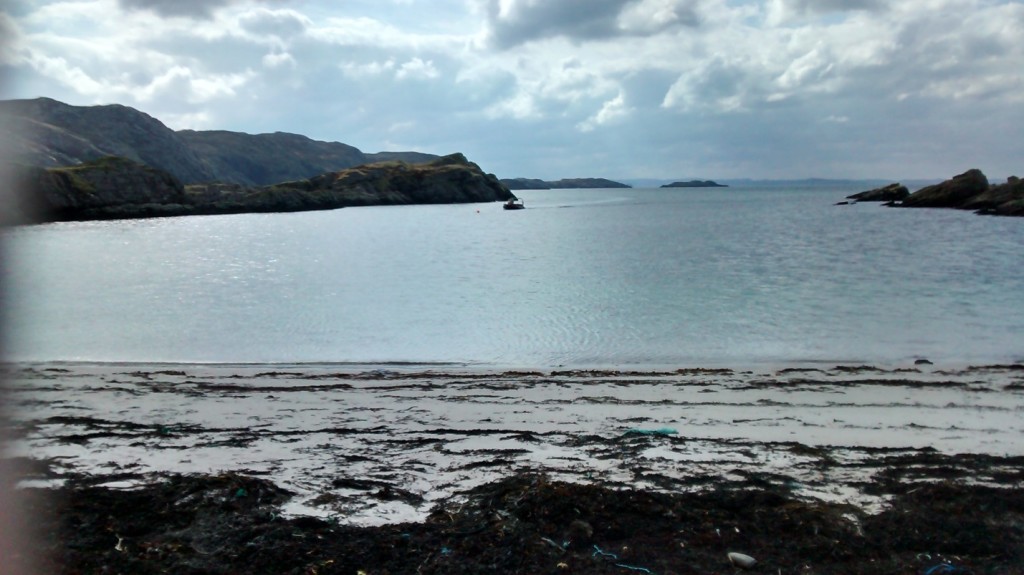
As we approached the island we could see that it was going to be a beach landing and the two 2016 season rangers were there waiting for us on the beach, one pushed up a portable jetty to the boat and the other held the boat steady so we could disembark safely. Just along from the boat in the water was a Black-throated Diver and on the beach some Oystercatchers and a Ringed Plover.
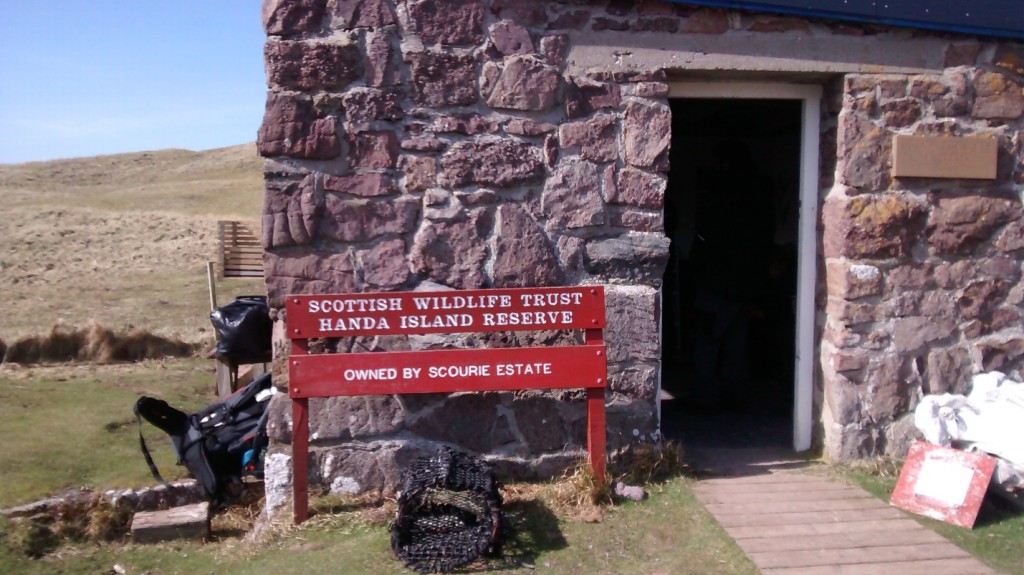
The rangers Tom and Danni welcomed us to Handa and helped us with our luggage up a very steep hill to the bothy where we would be staying for the week. On the way to the bothy we saw two Wheatears and a number of Skylarks plus a few rabbits running about on the hill just above the shelter.
The next day (Sunday) was a day off and Tom and Danni accompanied us around the visitors walk which is about 6km and took us about 3 hours.
On the Monday morning we put on thigh waders and the rangers Tom and Danni took us to the visitors shelter where we would be each day from 9am to 5pm. They gave us an introduction to our job on the island, which was to work with the ferry, we were given a radio each for communicating with Rodger and a mobile phone for contacting the rangers.
Rodger would radio us when he was bringing visitors to the Island, we would then go to the beach where one of us would operate the portable jetty and the other would steady the boat, once the jetty was in place then whichever of us was working the jetty would also steady the ferry boat and ensure the visitors disembarked safely.
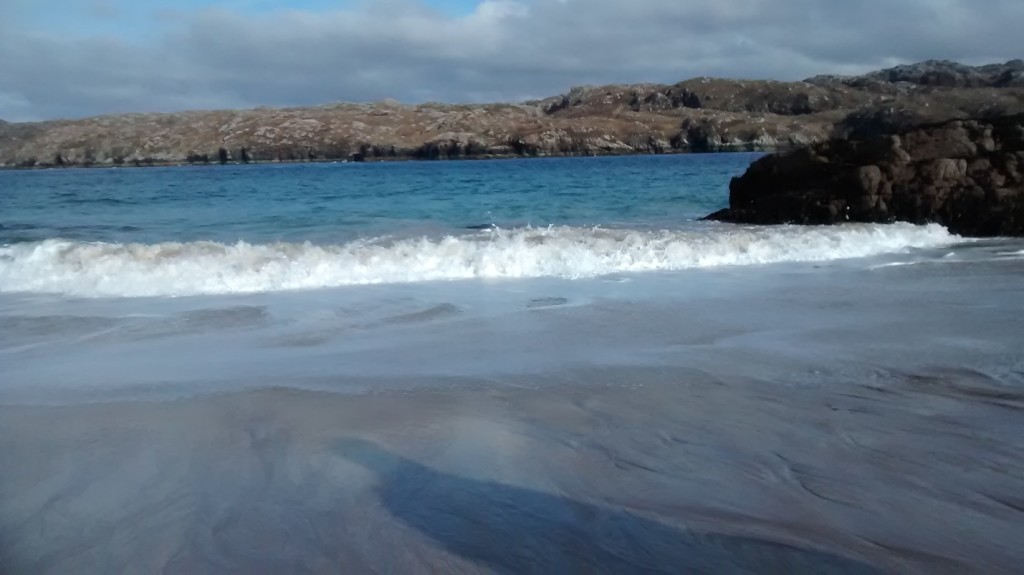
It wasn’t long before we received the first radio message from Rodger telling us he was on his way with a number of visitors and would be landing at the Lockie which was the name of one of two beaches used to land visitors on the island the other was Chapel bay but was simply known as The Beach so we headed down to the Lockie to meet the ferry.
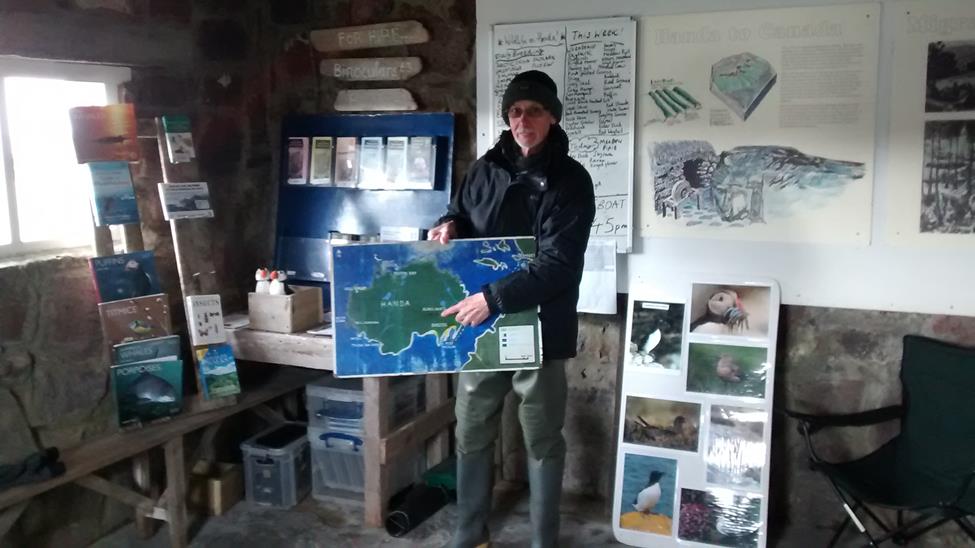
Once the visitors were safely on the beach we then accompanied them to the visitor shelter where Danni welcomed them to Handa and explained that the island was owned by Scourie estate and managed by Scottish Wildlife Trust. She gave them some information about the island and about their safety while on the island including providing them with a map showing points of interest and the rangers phone number in case of emergency.
Tom and Danni helped us with landing the visitors up until 2pm and then said they were happy that we were working well and left us on our own for the rest of the week. The 2pm ferry brought Kate and Andrew, the new assistant rangers that would be staying on the island for four months. Tom and Danni the season rangers stay on the island for six months.
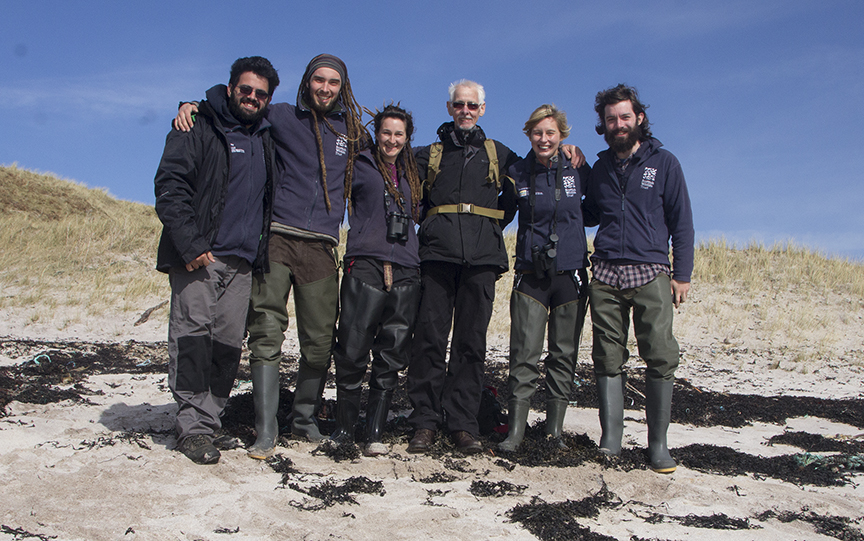
The Visitors Walk
After leaving the shelter visitors head up hill and the first point of interest is a ruined village which consisted of 6 black houses and 64 people and was occupied until the mid-19th century when after the potato famine in 1845, followed by two years of failed crops the last remaining people approached McIvor one of the Duke of Sutherlands factors and asked him to ask the Duke if he would pay their passage to Canada (Nova Scotia) which he did and spent around £200 on biscuits for their voyage.
Once the people left, sheep were then put on the island and sheep were the occupants right up until 2003.
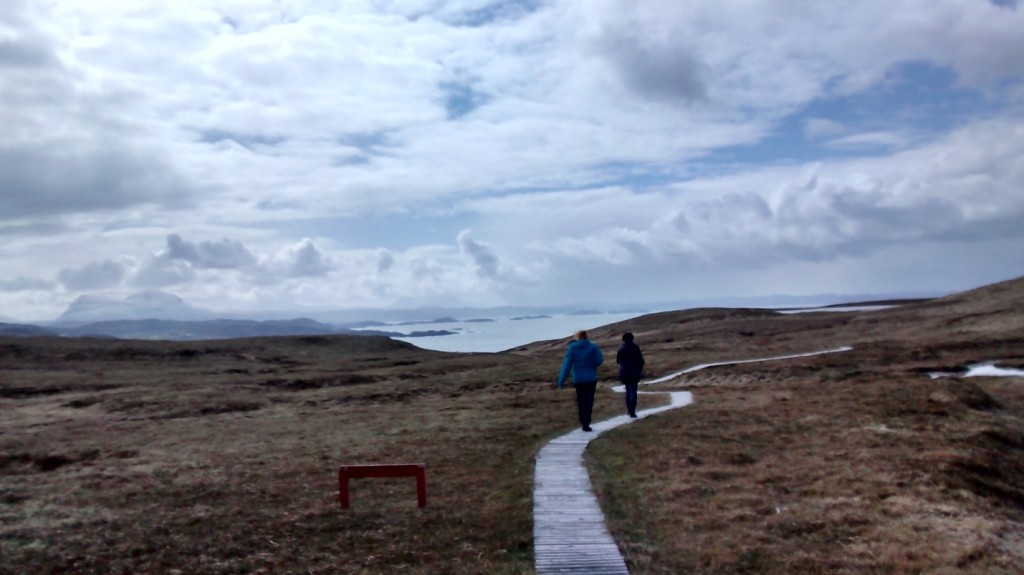
The walk continues north and visitors were advised to stay on the track for their own safety and so they don’t disturb nesting birds or damage the habitats. They pass an area of heath where the Great Skua (Bonxies), Red Grouse, and other birds nest, then arrive at the cliffs and Puffin Bay, where on sheer cliffs, with a vertical drop of around 120 metres and a small needle stack, they can see Puffins and Fulmars soaring in the wind. Artic Skuas, White-Tailed Eagles and Gannets can also be seen flying.
Also on the heath you can see flowers such as the Spotted Orchid and Lousewort, Bell Heather, Sea Mayweed, Roseroot, Thrift, Bluebell and numerous mosses and lichens, common lizards, newts, Magpie and Garden Tiger Moths.
Heading west along the cliffs the next place of interest is the Handa Great Stack, a huge tower of torridonian sandstone reaching up from sea level to the height of the cliffs some 120 metres high, the stack is almost impossible to climb and it has been said that more people have landed on the moon than have reached the top.
On the stack at times there are thousands of Guillemots which at times can reach some 66,000 plus there are Razorbills, Kittiwakes, Shags, Cormorants and Fulmars.
Heading south you can see the great wall, a huge torridonian sandstone wall, again with Guillemots, Razorbills, Fulmars and Puffins. Continuing south you come to Poll Ghlup (pronounced Paul Gloop), what a great name for a sink hole! This is a huge sink hole caused by a collapsed sea cave hundreds of feet below. The torridonian sandstone is also the bedrock of the island, over 1,000 million years old and provides perfect ledges on the cliffs for nesting birds.
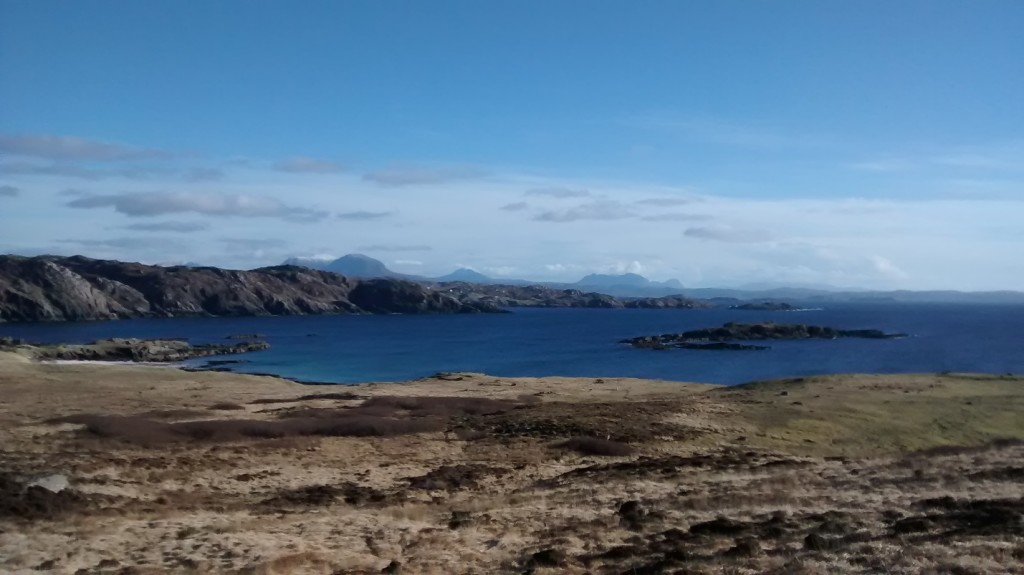
As you continue south and look west towards the Western Isles of Harris and Lewis, in the ocean if you are lucky you can see whales, dolphins, Porpoises, Basking sharks and seals.
The next place of interest is Boulder Bay here it is possible to see Otters and seals, further along are some more sandy beaches. The track then heads east and visitors arrive back at the shelter, we then radio the ferry and once it arrives we again operate the portable jetty and get them safely back on board for their trip back to the mainland. We do this several times a day and each visitor is informed that the last boat leaves at 5pm, also as visitors arrive on the island we keep a record of how many adults, children and under 5’s arrive on the island, how many leave and how many are on the island at all times insuring that everyone has left at the end of the day.
Once the last visitors are safely back on the ferry, that’s it, our days’ work is done, we complete the paperwork for the day and head back to the bothy for a meal after which we are free to explore the island or do whatever we want to do.
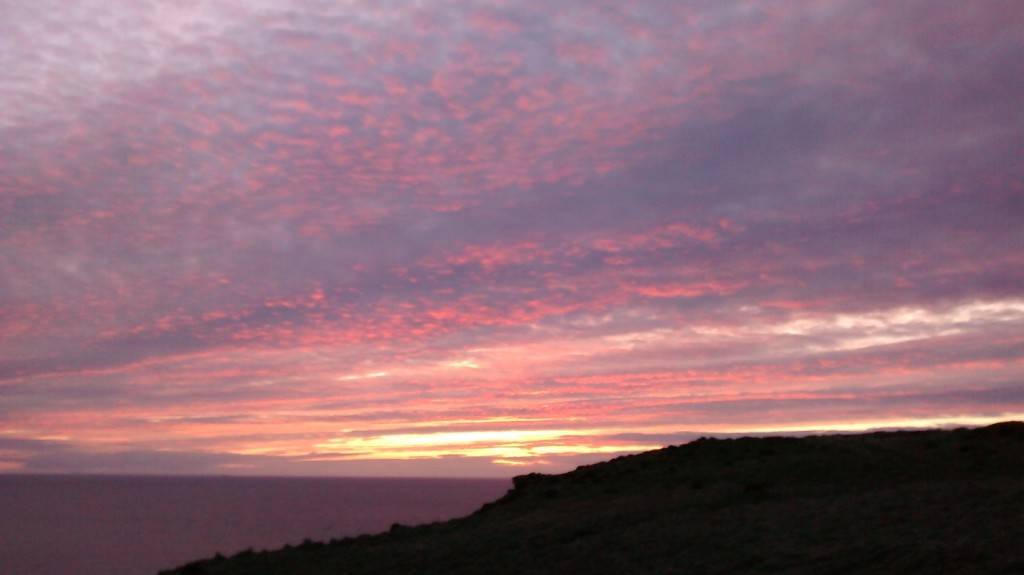
In the evenings you can hear numerous Snipe drumming with their tails, a very strange eerie sound and one I had never experienced before and sunsets on the island are simply amazing.
Sadly, Saturday come all too soon, our week on the island was over and it was time to leave but thanks to Scottish Wildlife Trust a great experience on an amazing Island, new friends made and after a few photographs and goodbyes we boarded the ferry as the next weekly volunteers disembarked.
On the way back I took Chris on a tour down the west coast to Ullapool and showed him the Corrieshalloch Gorge National Nature Reserve before heading back to Inverness and on to Perth stopping in Aviemore for Fish and Chips.
John Anderson – Scottish Wildlife Trust Volunteer, Montrose Basin
Handa Island recently featured on BBC One: Highlands – Scotland’s Wild Heart
Help protect Scotland’s wildlife
Our work to save Scotland’s wildlife is made possible thanks to the generosity of our members and supporters.
Join today from just £3 a month to help protect the species you love.
Preface
I had looked across to Handa island from the mainland a number of times and promised myself that one day I would visit the island as I heard it …
